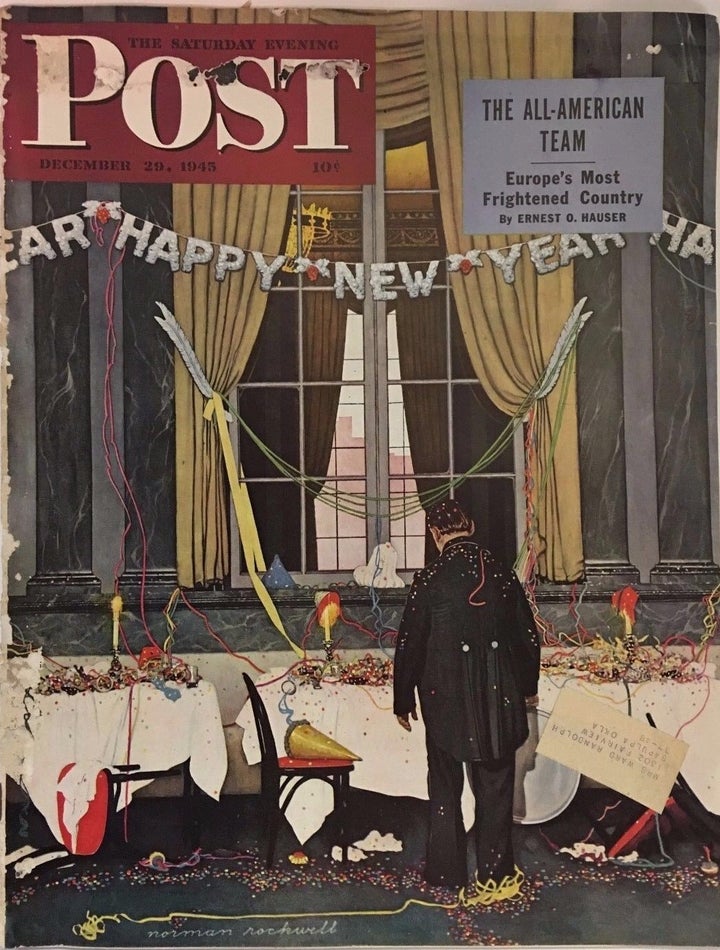
“Party’s Over” by Norman Rockwell
People think they know Norman Rockwell, and they look for what they expect of him. But so often he presented an image that defied their expectations. He wouldn’t settle for the easy solution, the usual story line. That is why he loved to hear people’s stories of their lives, their struggles, the comic moments of relief and surprise in the midst of the drama. He searched for what was real in the illusionary world of illustration and sought a synthesis of those two disparate realities.
“Party’s Over” appeared on the cover of The Saturday Evening Post on December 29, 1945 — almost four months after the long, drawn-out WWII ended, leaving an enervated nation staring into an unknown future.
And with just the back of a lone waiter, Rockwell reveals so much. Instead of the predictable exhausted revelry of a group of partiers, my grandfather chooses the solitary image of one man with a small build, his shoulders somewhat collapsed in a dejected feeling about the task at hand — to clean up after the others have had their champagne, their dancing, their fill. He is separate from all the trimmings of celebration — the ribbons, hats, confetti, yet he is covered with the remnants of the night. Strangely, all the glasses and bottles of champagne and liquor are already gone, removed.
He appears to be in a state ballroom or banquet hall, the regal gold curtains present a rigid, formal atmosphere in contrast to the reminders of the party’s chaos, frivolity, and perhaps rule breaking. The waiter, in his catering attire, his two-button jacket with tails, is having none of it — he has a job to do and he will do it, albeit somewhat reluctantly, the tray languishes at his side with his own stark, grey shadow reflected in it. The mirrored effect of another banquet hall adjoining this one and the light of day beckoning on the other side play with the idea of a light at the end of a tunnel. The candle lamps on the table still burn brightly.
Rockwell changes his signature to suit the occasion and image, as he often did; his name runs at the bottom of the canvas — almost unnoticed — mimicking the confetti ribbons above.
Of all the myriad images Pop could have chosen at the close of that tumultuous year, 1945, why did he choose this one of dejection, lethargy and solitude — of facing an unknown future without much joy, just focused on the job that needed to be attended to?
That was much the state of America at that time. World War II had taken a great toll — physically, emotionally and psychically — on the American people and everyone around the world. What comes next? the country and the world unconsciously seemed to be asking. We were in uncharted territory without a map or a guide. Film Noir, that darkened period of edgy Hollywood and world cinema that arrived in the early 40’s and matured after the War, appeared on screen out of this feeling of uncertainty and the cruelty of an unknown fate — the femme fatale — that seemed beyond our control.
Except we are a nation that was built on a strong and lasting vision. A vision that was born out of great difficulty and carnage — we are still a young country in comparison to the rest of the world — but a powerful vision that remains within us inherently without our prompting. And that is the continuing vision that Norman Rockwell was often able to capture in his almost 60 years as an illustrator, as our nation began to grow up, stumble, fall back, and pick itself up again and again with renewed vision and vigor.
This is who we were and who we are and will always be. A nation that will aspire, achieve, overstep, make errors, rectify itself, and begin again stronger and hopefully wiser. That is our essence as a nation. And it is the essence of Pop’s vision of America and its continuing progress technologically, emotionally and spiritually.
We can’t have the peace on earth we are seeking right now. Yet we can begin to find that peace within ourselves, our lives, and the life around us. That is how we regrow and expand the original vision for this country and our world. Nothing can happen without that profound and powerful vision. And we need to hold fast to that always evolving dream, now more than ever.
Our faith is not tested in periods of prosperity and pockets of time spent in blissful serenity. Our faith is made real in times of crisis, unknowing and disquiet. Those are the moments that reveal who we truly are, not who we hope to be or wish we were.
May 2017 be the year that marks the beginning of the great healing for our nation and the world, a year when even the smallest wishes peek through to see the light of day. Sometimes true healing only comes after the greatest crisis point is reached. That is why people continue to be drawn to the affirmative message of Rockwell. We know it is possible. And till our last breath we will breathe and live that truth with determination and grit because that is who we know we are and are struggling to become.
Warmest wishes for a bright New Year, in spite of everything.
Abigail
P.S. I chose this Google image of the actual Post cover with a worn address card affixed. I love the destroyed Post signage and tattered edges. Yet the quality of the reproduction is surprisingly lucid and un-degraded.
